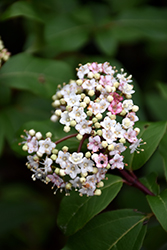It's all about ...
plants

Compact Laurustinus
Viburnum tinus 'Compactum'
Height: 5 feet
Spread: 5 feet
Sunlight:
![]()
![]()
Hardiness Zone: 7b
Other Names: Laurustinus
Description:
An attractive evergreen shrub that is smaller growing, producing white clusters of flowers over a long period from late winter until spring, followed by fruits in summer that turn royal blue; can tolerate more shade than most viburnums
Ornamental Features
Compact Laurustinus features showy cymes of lightly-scented white star-shaped flowers at the ends of the branches from late winter to early spring. The royal blue fruits are held in abundance in spectacular clusters in mid summer. It has dark green evergreen foliage. The pointy leaves remain dark green throughout the winter.
Landscape Attributes
Compact Laurustinus is a multi-stemmed evergreen shrub with a mounded form. Its relatively coarse texture can be used to stand it apart from other landscape plants with finer foliage.
This is a relatively low maintenance shrub, and should only be pruned after flowering to avoid removing any of the current season's flowers. It is a good choice for attracting birds to your yard, but is not particularly attractive to deer who tend to leave it alone in favor of tastier treats. It has no significant negative characteristics.
Compact Laurustinus is recommended for the following landscape applications;
- Accent
- Mass Planting
- Hedges/Screening
- General Garden Use
Planting & Growing
Compact Laurustinus will grow to be about 5 feet tall at maturity, with a spread of 5 feet. It tends to be a little leggy, with a typical clearance of 2 feet from the ground, and is suitable for planting under power lines. It grows at a medium rate, and under ideal conditions can be expected to live for 40 years or more.
This shrub does best in full sun to partial shade. It is very adaptable to both dry and moist locations, and should do just fine under average home landscape conditions. It is not particular as to soil type or pH, and is able to handle environmental salt. It is highly tolerant of urban pollution and will even thrive in inner city environments. This is a selected variety of a species not originally from North America.
This plant is not reliably hardy in our region, and certain restrictions may apply; contact the store for more information.

